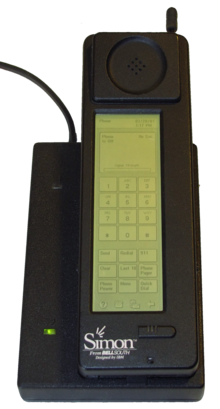 The Simon Personal Communicator shown in its charging base | |
| Brand | BellSouth (designed by IBM) |
|---|---|
| Developer | IBM |
| Manufacturer | Mitsubishi Electric Corp. |
| Type | Smartphone |
| First released | 1994[1] |
| Availability by region | United States August 16, 1994 (BellSouth Cellular) |
| Discontinued | February 1995 |
| Units sold | 50,000 |
| Predecessor | Angler (code name) |
| Compatible networks | AMPS |
| Form factor | Brick |
| Dimensions |
|
| Weight | 18 oz (510 g) |
| Operating system | Datalight ROM-DOS |
| CPU | NEC V30HL, 16 MHz, 16-bit, 8086-compatible CPU as part of Vadem VG230 System on a chip |
| Memory | 1 MB PSRAM (2× Hitachi HM658512LTT) 32 KB SRAM (Sony CXK58257) |
| Storage | 1 MB NOR Flash (Intel/Hitachi) expanded to 2 MB by Stacker compression + 32KB BIOS NOR Flash |
| Removable storage | Optional PCMCIA Flash RAM cards |
| Battery | 7.5V NiCad |
| Display | 4.5 in × 1.4 in (114 mm × 36 mm), 160 × 293 pixel CGA monochrome backlit LCD |
| Connectivity |
|
| Data inputs |
|
| References | [2][1][3][4][5] |
Preview warning: Page using Template:Infobox mobile phone with unknown parameter "Processor"
Preview warning: Page using Template:Infobox mobile phone with unknown parameter "price"
Preview warning: Page using Template:Infobox mobile phone with unknown parameter "carrier"
The IBM Simon Personal Communicator (simply known as IBM Simon) is a handheld, touchscreen PDA designed by International Business Machines (IBM), and manufactured by Mitsubishi Electric.[6] Although the term "smartphone" was not coined until 1995, because of Simon's features and capabilities, it has been retrospectively referred to as the first true smartphone.[2][7][8][9]
BellSouth Cellular Corp. distributed the IBM Simon in the United States between August 1994 and February 1995, selling 50,000 units. The Simon Personal Communicator was the first personal digital assistant or PDA to include telephony features (make phone calls). The battery lasted only an hour, and flip phones became increasingly slim which led to its demise.[10]
- ^ a b O'Malley, Chris (December 1994). "Simonizing the PDA". Byte. 19 (12): 145–148. ISSN 0360-5280. Archived from the original on February 21, 1999. Retrieved June 30, 2012.
The CPU is a 16-bit x86-compatible processor running at 16 MHz, a single-chip design manufactured by Vadem. Simon runs a version of DOS called ROM-DOS, from Datalight...
- ^ a b Sager, Ira (June 29, 2012). "Before IPhone and Android Came Simon, the First Smartphone". Bloomberg Businessweek. ISSN 2162-657X. Archived from the original on July 1, 2012. Retrieved June 30, 2012.
Simon was the first smartphone. Twenty years ago, it envisioned our app-happy mobile lives, squeezing the features of a cell phone, pager, fax machine, and computer into an 18-ounce black brick.
- ^ "Bellsouth, IBM Unveil Personal Communicator Phone". Mobile Phone News. November 8, 1993. ISSN 0737-5077. Retrieved June 30, 2012.
The phone currently is based on an AMPS standard...
- ^ "BellSouth: IBM Simon PDA Cellphone". RetroCom. Retrieved June 30, 2012.
Graphic display: 160 x 293
- ^ Nochkin, Alexandr (July 10, 2013). "IBM Simon. The first smartphone in the World. What's inside". IBM blog (in Russian). Habrahabr.ru. Retrieved June 5, 2017.
- ^ Jin, Dal Yong (2017). Smartland Korea: Mobile Communication, Culture, and Society. University of Michigan Press. pp. 34–35. ISBN 9780472053377.
- ^ "Ericsson GS88 Preview". Eri-no-moto. 2006. Archived from the original on January 11, 2012. Retrieved December 15, 2011.
- ^ "Penelope Box". Stockholm Smartphone. 2010. Archived from the original on February 3, 2012. Retrieved December 15, 2011.
- ^ Savage, Pamela (January 1995). "Designing a GUI for Business Telephone users". Interactions. 2. Association for Computing Machinery: 32–41. doi:10.1145/208143.208157. S2CID 19863684. Retrieved September 13, 2014.
...It is at this point that early usability test participants met impasse. The switch connected to our "smart phone" is expecting the typical "dumb end-point"... AT&T's PhoneWriter was demonstrated at the 1993 Comdex Computer Show...
- ^ First Smartphone Turns 20: Fun Facts About Simon, 2014-08-18.